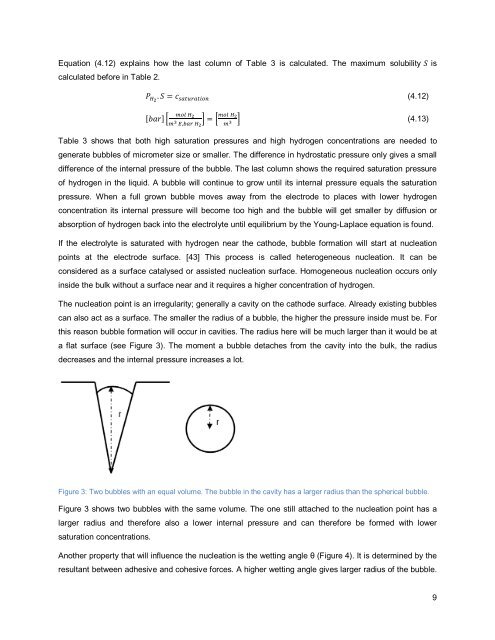A bubble curtain model applied in chlorate electrolysis
A bubble curtain model applied in chlorate electrolysis
A bubble curtain model applied in chlorate electrolysis
Create successful ePaper yourself
Turn your PDF publications into a flip-book with our unique Google optimized e-Paper software.
Equation (4.12) expla<strong>in</strong>s how the last column of Table 3 is calculated. The maximum solubility S is<br />
calculated before <strong>in</strong> Table 2.<br />
P H2 . S = c saturation (4.12)<br />
mol H 2<br />
[bar] = mol H 2<br />
(4.13)<br />
m 3 E,bar H 2 m 3<br />
Table 3 shows that both high saturation pressures and high hydrogen concentrations are needed to<br />
generate <strong>bubble</strong>s of micrometer size or smaller. The difference <strong>in</strong> hydrostatic pressure only gives a small<br />
difference of the <strong>in</strong>ternal pressure of the <strong>bubble</strong>. The last column shows the required saturation pressure<br />
of hydrogen <strong>in</strong> the liquid. A <strong>bubble</strong> will cont<strong>in</strong>ue to grow until its <strong>in</strong>ternal pressure equals the saturation<br />
pressure. When a full grown <strong>bubble</strong> moves away from the electrode to places with lower hydrogen<br />
concentration its <strong>in</strong>ternal pressure will become too high and the <strong>bubble</strong> will get smaller by diffusion or<br />
absorption of hydrogen back <strong>in</strong>to the electrolyte until equilibrium by the Young-Laplace equation is found.<br />
If the electrolyte is saturated with hydrogen near the cathode, <strong>bubble</strong> formation will start at nucleation<br />
po<strong>in</strong>ts at the electrode surface. [43] This process is called heterogeneous nucleation. It can be<br />
considered as a surface catalysed or assisted nucleation surface. Homogeneous nucleation occurs only<br />
<strong>in</strong>side the bulk without a surface near and it requires a higher concentration of hydrogen.<br />
The nucleation po<strong>in</strong>t is an irregularity; generally a cavity on the cathode surface. Already exist<strong>in</strong>g <strong>bubble</strong>s<br />
can also act as a surface. The smaller the radius of a <strong>bubble</strong>, the higher the pressure <strong>in</strong>side must be. For<br />
this reason <strong>bubble</strong> formation will occur <strong>in</strong> cavities. The radius here will be much larger than it would be at<br />
a flat surface (see Figure 3). The moment a <strong>bubble</strong> detaches from the cavity <strong>in</strong>to the bulk, the radius<br />
decreases and the <strong>in</strong>ternal pressure <strong>in</strong>creases a lot.<br />
Figure 3: Two <strong>bubble</strong>s with an equal volume. The <strong>bubble</strong> <strong>in</strong> the cavity has a larger radius than the spherical <strong>bubble</strong>.<br />
Figure 3 shows two <strong>bubble</strong>s with the same volume. The one still attached to the nucleation po<strong>in</strong>t has a<br />
larger radius and therefore also a lower <strong>in</strong>ternal pressure and can therefore be formed with lower<br />
saturation concentrations.<br />
Another property that will <strong>in</strong>fluence the nucleation is the wett<strong>in</strong>g angle θ (Figure 4). It is determ<strong>in</strong>ed by the<br />
resultant between adhesive and cohesive forces. A higher wett<strong>in</strong>g angle gives larger radius of the <strong>bubble</strong>.<br />
9















